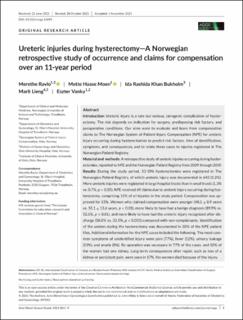| dc.description.abstract | Introduction: Ureteric injury is a rare but serious, iatrogenic complication of hysterectomy. The risk depends on indication for surgery, predisposing risk factors, and peroperative conditions. Our aims were to evaluate and learn from compensation claims to The Norwegian System of Patient Injury Compensation (NPE) for ureteric injury occurring during hysterectomies to predict risk factors, time of identification, symptoms, and consequences, and to relate these cases to injuries registered in The Norwegian Patient Registry. Material and methods: A retrospective study of ureteric injuries occurring during hysterectomies, reported to NPE and the Norwegian Patient Registry from 2009 through 2019. Results: During the study period, 53 096 hysterectomies were registered in The Norwegian Patient Registry, of which ureteric injury was documented in 643 (1.2%). More ureteric injuries were registered in large hospital trusts than in small trusts (1.3% vs. 0.7%, p < 0.05). NPE received 69 claims due to ureteric injury occurring during hysterectomy, comprising 11% of all injuries in the study period. Compensation was approved for 15%. Women who claimed compensation were younger (48.1 ± 8.9 years vs. 55.1 ± 13.6 years, p < 0.01), more likely to have had a benign diagnosis (89.9% vs. 52.1%, p < 0.01), and more likely to have had the ureteric injury recognized after discharge (58.0% vs. 33.0%, p < 0.001) compared with non-complainants. Identification of the ureters during the hysterectomy was documented in 30% of the NPE patient files. Additional information for the NPE cases included the following. The most common symptoms of unidentified injury were pain (77%), fever (12%), urinary leakage (13%), and anuria (8%). Re-operation was necessary in 77% of the cases, and 10% of the women lost one kidney. Long-term consequences after repair, such as loss of a kidney or persistent pain, were seen in 17%. No women died because of the injury. Conclusions: The incidence of ureteric injury occurring during hysterectomy in Norway was 1.2%; 11% involved a claim for compensation, and 15% of these had their case approved. Most ureteric injuries were not recognized during the hysterectomy. Documentation of peroperative identification of the ureters during hysterectomy was often missing. Vigilance to pain as a postoperative symptom of peroperative unrecognized ureteric injury may result in earlier diagnosis and treatment. | en_US |

